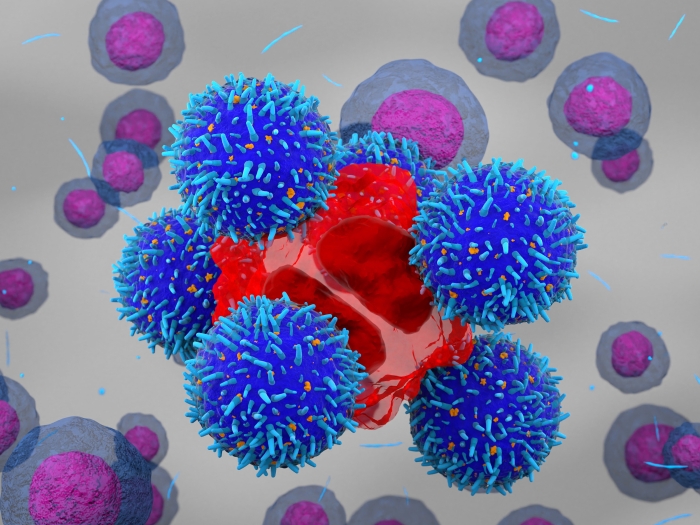For greater reliability and reproducibility
BAB is a tall, quiet, and infatigable robot. BAB lives at the University of Michigan North Campus Research Complex, in Dr. Indika Rajapakse’s lab (Department of Computational Medicine & Bioinformatics, Mathematics and Biomedical Engineering) where interdisciplinary research aims to understand how cells could be reprogrammed to generate new cells that restore tissue function in injury or disease. The goal of this work is ultimately to create a universal platform for reprogramming any cell into any other cell, and to use those cells to fabricate a tissue on-demand.
To achieve this goal, this team of scientists needs impeccable repeatability of results. And this is where BAB comes in. BAB, short for BioAssemblyBot® (Advanced Solutions), is a robot that is affectionately referred to as “she.” BAB can pipette, handle cell cultures, perform complex molecular biology protocols and is highly precise in everything she does. “With BAB, our results are very reliable because we can precisely repeat the same experiment over many different samples,” said Rajapakse. “She also saves a lot of lab time and can execute tasks after hours.”
“With BAB, our results are very reliable because we can precisely repeat the same experiment over many different samples.”
—Indika Rajapakse, Ph.D.
BAB interacts with other state-of-the-art pieces of equipment, in particular an RNA / DNA sequencer, a very high-resolution microscope and, of course, super powerful computers. “With BAB, it is very easy to go through all the experiment steps. She provides a smooth workflow and is easy to program,” said lab manager Walter Meixner. “BAB is highly adaptable to user needs, sporting an X-box controller for users to customize her movement.”
For example, the team studies fibroblast cells that are integral to the maintenance of connective tissues. In particular, dermal fibroblasts play an essential role in wound healing. To observe the process by which the skin tissue heals, the scientists “simply” scratch a model of the dermis and digitally record how fibroblast cells behave. However, in order to reliably replicate this experiment across samples, the scratch has to be the same each time, and that is BAB’s role: she performs the exact same scratch on all the tissue samples. The cellular reaction to the scratch is then recorded under a microscope in a composite image of nine rectangular areas, all recorded and sampled at a predefined cadence. These frames are then digitally assembled to reconstitute the entire tissue and render the cell movements over time. The result shows a video in which fibroblast cells move fast toward the void created by the scratch, filling the gap where they also start reproducing faster than in other areas of the tissue. Once this two-prong reaction is observed, the next step is to further explore the biological mechanisms that trigger it. This experiment, supported by highly sophisticated technology, brings further insight into the very complex biological processes involved in cellular differentiation and reprogramming.
BAB can also separate cells into different types using special magnets. This skill is particularly helpful to study immune cells in the context of metabolic disease/diabetes in obesity. Dr. Lindsey Muir spearheads this research in the Rajapakse lab. She specifically investigates changes in innate immune cells (e.g., macrophages) in adipose tissue in obesity and studies the triggers for these changes in early obesity. Her goal is to understand the spectrum of different types of macrophages that appear in obesity and what they are doing in the tissue. Her experiment design requires many samples or plates that have 96+ wells and she must factor in human physical and mental fatigue because either can result in errors. Without BAB, she would have to spread an experiment over two days or limit the number of replicates and controls included. "BAB enables me to think differently about my work. With BAB’s efficiency, we can include additional replicates and controls while focusing our human effort on designing the best possible experiments. Having automatically recorded metadata is a bonus, including total time for a protocol and the time of day,” she said.
"BAB enables me to think differently about my work.”
—Lindsey Muir, Ph.D.
Of all her capabilities, one of BAB’s most exciting features might be that she can 3-D bioprint. In this mode, she gently extrudes cells along with biomaterials in precise patterns to replicate a living tissue. Using this capability the Rajapakse lab is working with Jay Hoying (Advanced Solutions) and iReprogram, Inc. on 3-D fabrication of bone marrow. The group hopes to demonstrate how robotics-assisted automation can benefit biologists and help move biological science forward.
BAB purchase was made possible in 2022 thanks to funding from the Defense University Research Instrument Program (DURIP).
In so many ways, BAB is impacting biomedical research, making it more reliable and efficient!
Video: https://drive.google.com/file/d/1My2Un0Zj3QqaqoS_gmuicf6AvW4nlDCM/view

Professor





